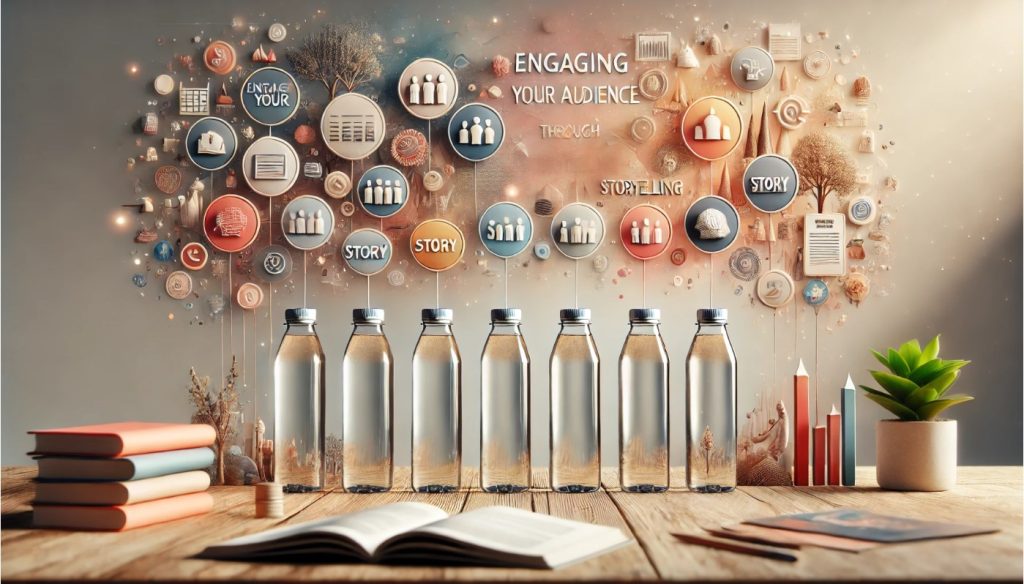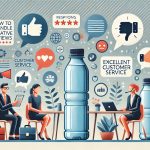Storytelling has become one of the most powerful tools for brands seeking to connect with their audience on a deeper level. It’s not just about selling a product—it’s about sharing a narrative that resonates, evokes emotion, and fosters a sense of connection. For water bottle brands, storytelling can be a transformative tool that humanizes your product, demonstrates its value, and ultimately drives customer loyalty.
Water bottles may seem like a simple product, but when you embed a compelling story around them, they become much more. Whether it’s about the sustainable materials you use, the craftsmanship behind each bottle, or the brand’s commitment to environmental preservation, storytelling can elevate your water bottles from a mere commodity to a symbol of something bigger.
The Power of Storytelling in Branding
Building Emotional Connections
In a crowded marketplace, consumers are drawn to brands that evoke emotions and resonate with their values. Water bottles are functional items, but through storytelling, they can take on meaning beyond their primary purpose. A well-crafted brand story can foster a sense of belonging, appeal to a customer’s values, and even align with their lifestyle choices.
For instance, if your brand is committed to sustainability, you could tell the story of how your bottles are made from recycled materials, reducing plastic waste and supporting eco-friendly practices. Such a story appeals to consumers who prioritize environmental consciousness and want to make a positive impact through their purchasing decisions. The emotional connection that arises from this alignment with values makes customers more likely to trust your brand and remain loyal to it.
Distinguishing Your Brand from Competitors
In industries where products often appear similar—like water bottles—storytelling becomes a way to differentiate your brand from the competition. A well-told story adds personality and character to your brand, making it memorable in the minds of consumers. Instead of just being another bottle on the shelf, your product can represent something unique and valuable.
Take, for example, the story of how your water bottles were designed for people who live active, on-the-go lifestyles. Or, perhaps the inspiration for your design came from a place, culture, or experience that speaks to your brand’s values. Sharing these types of stories helps set your product apart from others that may lack a personal or meaningful connection.
Creating Long-Term Relationships
Brands that use storytelling are more likely to build long-term relationships with their customers. Storytelling engages consumers in an ongoing dialogue, keeping them connected to the brand’s mission, values, and development. Water bottle brands that share their journey, not just their product features, foster a deeper sense of community and brand loyalty.
By sharing behind-the-scenes stories about how your bottles are made, who’s behind the brand, or the milestones your company has achieved, you can cultivate a sense of shared experience with your audience. Over time, customers become invested in your brand’s success, which leads to stronger, more lasting relationships.
Crafting a Compelling Story for Your Water Bottle Brand
Defining Your Brand’s Mission and Values
The foundation of your storytelling strategy should lie in your brand’s mission and values. What does your brand stand for? Why did you create your water bottles in the first place? Defining these core elements gives you a solid foundation upon which to build your story.
For example, if your mission is to reduce single-use plastics and promote sustainability, this can be a key theme throughout your brand story. You can highlight the environmental challenges you aim to address and share how your bottles provide a solution. Perhaps your brand’s story began with a founder’s personal journey towards sustainability, or an experience that opened their eyes to the harmful effects of plastic waste. By aligning your brand’s narrative with values that resonate with your audience, you create an authentic story that’s easy for customers to connect with.
Best Practices for Defining Your Brand Story
- Focus on Authenticity: Authenticity is crucial in storytelling. Avoid fabricating or exaggerating details in order to make your brand seem more appealing. Customers appreciate honesty and transparency.
- Align with Consumer Values: Ensure that your brand’s mission and values resonate with your target audience. Understand what your customers care about, and weave these values into your brand’s story.
- Tell Your “Why”: Share why you started your brand. Did you see an unmet need in the market? Were you motivated by a particular cause? Customers love to hear the “why” behind a brand—it creates a sense of purpose.
Highlighting the Origin Story of Your Water Bottles
The origin story of your water bottles—the “why” behind their creation—can be one of the most compelling aspects of your brand’s narrative. Whether it was born out of a passion for reducing plastic waste, a desire to create an aesthetically pleasing yet functional product, or a commitment to improving people’s hydration habits, your story should showcase how your product came to life.
For example, your water bottle brand could have started as a simple idea or a solution to a personal challenge. Maybe the founder needed a bottle that was durable, stylish, and easy to carry while hiking, and there wasn’t one on the market that met their standards. This led to a journey of trial and error, design iterations, and eventual success.
Elements of a Strong Origin Story
- Challenge: What problem did you identify in the marketplace or in your personal experience that led you to create your water bottle brand?
- Journey: Describe the process of bringing the idea to life—did you face obstacles or unexpected turns along the way?
- Resolution: Explain how your brand ultimately found a solution and how it’s making a positive impact on customers’ lives.
Showcasing the Craftsmanship and Design Process
Many water bottle brands differentiate themselves through high-quality craftsmanship, innovative designs, and attention to detail. Telling the story of how your bottles are designed and made can captivate your audience and give them a deeper appreciation for the product.
You can delve into the materials you use, whether they are BPA-free plastics, stainless steel, or eco-friendly components. If your water bottles are designed with a focus on ergonomics, portability, or temperature control, share the thought process behind these features. Did you partner with designers to develop the most functional, aesthetically pleasing bottles? Did you use customer feedback to refine your design?
How to Highlight Craftsmanship and Design
- Behind-the-Scenes Content: Show your audience the design process, whether it’s through photos, videos, or blog posts that highlight the stages of product development.
- Sustainability Focus: If sustainability is a key element of your design process, share the steps you take to ensure that your water bottles are environmentally friendly—from material selection to production practices.
- Highlight Innovation: If your bottles incorporate unique features, such as double-wall insulation, leak-proof lids, or customizable options, be sure to explain the innovative thinking behind these features.
Incorporating Customer Stories and Testimonials
Customer testimonials are a powerful extension of your brand’s story. When you share the experiences of customers who love your water bottles, it brings authenticity and relatability to your narrative. Customers often see themselves in the stories of others, so hearing how your product has improved someone else’s life can have a profound impact on their decision to purchase.
Integrating customer stories into your broader narrative can help make your brand feel more human and less like a faceless entity. These stories also serve as social proof, reinforcing the value of your water bottles through the experiences of real people.
Best Practices for Customer Testimonials
- Use Specificity: Encourage customers to be specific about how your water bottle has improved their lives. This could be in terms of design, convenience, or environmental impact.
- Feature Real People: Show diversity in the testimonials you feature. Customers want to see people like themselves using your product.
- Visual Storytelling: Where possible, include photos or videos of customers using your water bottles in real-life situations. These visuals can enhance the storytelling and make the experience feel more genuine.
Delivering Your Brand Story Across Multiple Channels
On Your Website
Your website is the primary platform for sharing your water bottle brand’s story. You can weave your narrative throughout the website, from the homepage to the product pages, and even in the blog or “About Us” section. Ensure that the storytelling elements are seamlessly integrated into the design and messaging of the website.
Tips for Website Storytelling
- Hero Section: Use your homepage’s hero section to introduce your brand’s mission and unique selling proposition. This could include a brief description of your origin story or a key value proposition that sets you apart.
- Product Pages: On each product page, tell the story of the product’s design, materials, and benefits. This helps potential customers understand not just what they’re buying, but why they’re buying it.
- Interactive Features: Use storytelling elements like video or interactive features to engage visitors on your website. A video of your founder explaining the brand’s story or a timeline of your company’s milestones can captivate visitors.
Through Social Media
Social media provides a dynamic platform for sharing your water bottle brand’s story in real-time. Use these channels to tell ongoing parts of your brand’s journey, highlight customer experiences, and engage directly with your audience.
Platforms like Instagram and TikTok are perfect for visual storytelling, while Facebook and Twitter are great for longer-form content and direct engagement with customers. Regularly post behind-the-scenes content, product launches, and customer stories to keep your audience connected to the brand.
Social Media Storytelling Strategies
- User-Generated Content: Encourage your customers to share their own stories with your water bottles. Reposting user-generated content (UGC) not only provides social proof but also strengthens your relationship with customers.
- Live Content: Host live Q&A sessions or behind-the-scenes streams where your audience can learn more about your brand, products, and values in a real-time, interactive way.
- Instagram Stories and Reels: Use these features to share short, engaging snippets of your brand story, whether it’s a glimpse into your production process or an inspirational story of how your brand came to life.
Through Email Campaigns
Email marketing is an excellent way to keep your audience engaged with your water bottle brand’s story. Regularly update your customers with company news, product launches, or special promotions. You can also use email to share deeper insights into your brand story, such as customer success stories, sustainable practices, or upcoming milestones.
Tips for Storytelling in Email Campaigns
- Segment Your Audience: Tailor your emails to specific customer segments based on their past purchases or engagement with your brand. For example, eco-conscious customers might appreciate stories about your sustainability efforts.
- Storytelling Series: Consider creating a series of emails that take customers through your brand’s journey—from the founding story to the latest product innovations.
By engaging your audience through storytelling, your water bottle brand can create lasting emotional connections, build a loyal customer base, and stand out in a competitive market. Whether you are sharing your brand’s mission, highlighting the craftsmanship of your products, or showcasing customer testimonials, storytelling has the power to turn ordinary products into something extraordinary.







